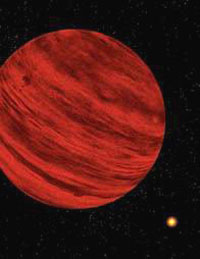|
|
 |
Bright X-rays,
Dim Dwarfs
by Kristin Leutwyler
In Depth / July
17, 2000 |
|
Celestial brown dwarfs are not unlike Dopey of Snow White's set. In
other words, they're far from the brightest lights in the sky. Though
bigger than the biggest planets, they are smaller than the smallest
stars, which themselves have just enough mass to sustain thermonuclear
reactions in their cores. Because of their size, brown dwarfs, also
called failed stars, can only shine about one tenth of a percent as
brightly as our own sun. Indeed, these objects are so dim that, although
astronomers predicted their existence in the 1960s, no one actually
found any until 1995.
|
 |
Image: NASA
FLARE of X-rays, seen in the bottom frame, shot unexpectedly from the
brown dwarf LP 944-20 on December 15, 1999.
So imagine the surprise scientists working with
NASA's Chandra X-ray
Observatory felt when, nine hours into an otherwise uneventful, 12-hour
look at the brown dwarf LP 944-20, it suddenly unleashed a bright
x-ray
flare. "We were shocked," says Robert Rutledge, a professor at the
California Institute of Technology and the lead author of a paper
published in the July 20 issue of Astrophysical Journal Letters. "This
is really the mouse that roared. We didn't expect to see flaring from
such a lightweight object." |
|

Image: Pat Rawlings
BROWN DWARFS, contrary to their name, actually appear red and are
sometimes companions to stars, as shown in this illustration. |
What they had expected was to detect a few photons every hour, adds
Lars Bildsten, a member of the team from the University of California at Santa
Barbara. Rather, brown dwarfs, lacking the mass to support powerful
fusion reactions, get most of their energy from the gradual release of
gravitational energy as they contract a few inches a year. "It was as if
we were searching for a dim bulb and instead found a bright flash of
light." In fact, the energy emitted in the flare was comparable to that
of a small solar flare and was one billion times greater than x-ray
flares coming from Jupiter.
This surprisingly dynamic flare offers new insight into objects ranging
in size from extremely low-mass stars down to gas-giant planets. "This
is the strongest evidence yet that brown dwarfs and possibly even young
giant planets have magnetic fields," noted another team member from
Caltech, Eduardo Martin. (In 1992 Martin and his colleagues at the
Astrophysics Institute of the Canary Islands were first to propose the
lithium test, a clever method for detecting brown dwarfs.)
Principal investigator Gibor Basri guesses that the flare may have
resulted from turbulent magnetized hot material below LP 944-20's surface
that produced a twisted magnetic field. "A subsurface flare could heat
the atmosphere, allowing currents to flow and give rise to the x-ray
flare--like a stroke of lightning," he remarked. And the nine-hour
absence of flaring, the team reports, shows that coronas, or million
degree Celsius upper atmospheres, cease to exist when a brown dwarf's
surface cools below 2,500 degrees C. It also sets the lowest limit for
steady x-ray production from a brown dwarf.
Although this x-ray flare is the first ever witnessed from a brown dwarf,
it most likely won't be the last. Brown dwarfs appear to be plentiful. "New
sky surveys show that the objects may be as common as stars," Basri
confirms. LP 944-20, a 500-million-year-old object about 60 times larger
than Jupiter and 16 light-years from Earth, is just one of the closest.
But other brown dwarfs are probably also sending up flares, waiting to
be seen.
|


